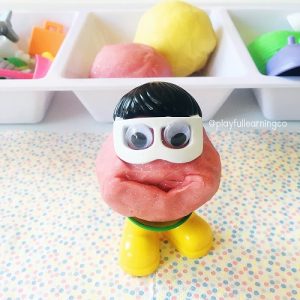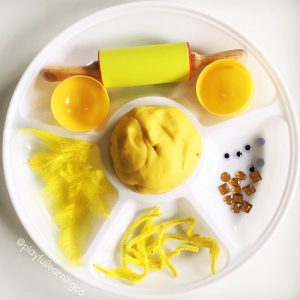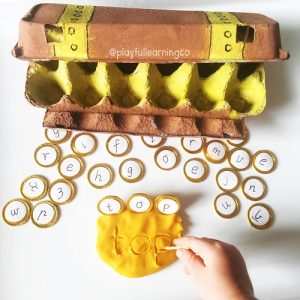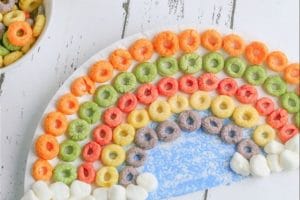
It’s no surprise that when I became a Mum myself I went a little nuts making it – we have at least 3 different colours in the fridge at all times! It’s so open ended, and with 4 children of my own now (aged 5, 4, 2.5 and 6 months old) anything that I can set up that entertains all 4 (well…the older 3 at least!) ticks all the boxes for me.
Here are 10 of our favourite things to do with playdough (and the sneaky learning benefits for each!):
TODDLERS AND PLAYDOUGH
- Eggs in the kitchen

- Rolling into snakes

- Snipping playdough snakes
Looking to introduce scissors to your child? Playdough to the rescue! After rolling the dough into snakes, give your child a pair of dough scissors (or normal scissors) and let them snip away! Encourage your child to get creative with the ‘snippings’ – add them to a little pot to make ‘dinner’, use them as playdough hair for alien creatures or crazy eyes for a face. (Disclaimer: if you use as many colours as this rainbow pic, they will inevitably end up a questionable poo-like colour. Don’t say I didn’t warn you!)
- Mr Playdough Head

- Learn your colours

Adding different items to playdough also encourages flexibility in thinking, planning and reflecting and, of course, encourages creativity and imagination. It is a fantastic way of giving new life to items that they may not have played with for awhile. A quick note: googly eyes make EVERYTHING fun, but just be mindful of your child – you know them best! Do not offer small items for play if you know they are still putting things in their mouth. Safety first!
‘BIG KIDS’ AND PLAYDOUGH
In the race to learn sight words and develop numeracy skills, playdough is often overlooked once a child starts ‘big school’. The best thing about any open-ended item is that it can be adapted to suit all ages! My older children (both boys) love playing with it just as much as my toddler does – and it is just as beneficial for them. Here’s some ways my school aged kiddos play with playdough:
- Letters and Words

Invite children to make words (or individual sounds / letters of their name depending on where they’re at). If you don’t have alphabet stampers, no worries! Encourage them to roll out the playdough into snakes and form letters that way – this is fantastic for their finger skills. If you are using letter stampers, try popping the letters in the freezer to make it easier to move the letters around without breaking them. Rolling and flattening out cold and partially frozen playdough also adds an extra fine motor workout. Plus it’s a cool investigation – the dough doesn’t freeze due to the high salt content! Try it for yourself.
- Word Bang

- Pirate Writing

- Item hunt
A correct pencil grip comes automatically for some children, but for many others, they need explicit assistance to develop the strength in their hands so they can do it correctly. Developing the strength and in-hand manipulation skills necessary for good pencil grip is as simple as using playdough! (I told you playdough was amazing.)
Hide some objects, like pirate coins or real coins into playdough and ask your child to find these objects. Once they have found them, ask them to place these items in the palm of one hand. Encourage them to move the object in the palm of their hand to the tips of their fingers and thumb. Once here, get them to post it into a money box or an empty box with a slit in the top.
- Hide and seek sight words

Hide 3 or 4 letters (magnetic letters will do) into balls of playdough. Encourage your child to find the letters and work out what the word could be! My boys love it when I take it in turns with them – they love being teacher, hiding a secret word in the dough for me to discover. This also provides a great opportunity for me to model how to sound out words, reinforcing what they’ve been doing at school. We also have races, with each of us having a ball of dough with ‘mystery’ letters in it – the first one to find the letters and make the word is a winner!
Try Baby Hints and Tips recipes for edible playdough and the softest playdough ever.
This is just a teeny tiny insight into the amazing possibilities of playdough! Come and check out my Instagram feed (@playfullearningco) for more fun and playful ideas!














Pingback: Oh Creative Lady: Meet Amy from Playful Little Learners - Oh Creative Day